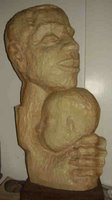
Thought for the day:
Timber is propping up technology in homes and offices around the world. Look at what holds your computer boxes. Whatever happens in the world of technology we apparently cannot do without wood.
(The picture shows a sculpture in silky oak, Father and Child, by Jenny Rumney. http://www.geocities.com/rumneyjenny ).
More about wood and technology at http://classiecorner.blogspot.com/2006/06/old-wood-robe-that-was-bargain-at.html
CASES of woodworkers with damaged lungs are a continuing worry in the community of classified advertising.
Classie Corner must warn woodworkers to use the recommended breath protection. And we’re not talking about Colgate, Macleans and Listerine.
Use the right masks in the right way and maintain the filters.
Turners seem to suffer badly from lung damage after repeatedly inhaling the fine dust.
The column, below, includes a reference to the problem. In this instance the sufferer says he turned for about a decade before he woke up to the damage he was doing.
Another 10 years on, he can no longer work on the lathes. That must be heart breaking for anyone who loves wood.
Camphor laurel, rosewood and rose mahogany were his specialties. He took the trade to a high level by opening a woodturners’ gallery in a suburban business district.
I turned for about six months in 2000 and believe it affected my lungs, even though I wore a rubber mask with renewable filter.
All woodturners complain that masks don’t seem to work properly. They are awkward and hard to seal around the face.
Mine seemed to seal. It left lines around my cheekbones for quite a while after removal.
X-rays have failed to detect any damage that could be blamed specifically on the dust but I continue to worry, having another lung-dusted turner in the family.
I still come across turners who believe they can beat the dust by controlling their breathing as they work.
The technique seems to involve holding your breath while you work and moving out of the perceived dust zone to inhale or breathing very shallowly.
Evidence suggests it is a dangerous practice.
No comments:
Post a Comment